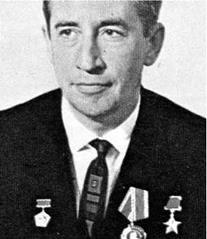Planning the lunar landing
After the flight of the First and Second Cosmic Ship and then the Automatic Interplanetary Station, the full attentions of OKB-1 switched to manned spaceflight. Design of the first manned spaceship gathered pace over 1959, culminating in the launch of the first prototype, Korabl Sputnik, on 15th May I960. The rest of the year was spent on refining the design, testing and preparing the first team of cosmonauts for flight. Only after five Korabl Sputnik missions, with dummies and dogs, were the Russians prepared to commit a cosmonaut to such a mission, called for the purpose the Vostok spacecraft. Vostok was a spherical spacecraft, riding on an equipment module, weighing four tonnes, able to fly a cosmonaut in space for up to ten days.
VOSTOK ZH: A CONCEPTUAL STUDY
This did not mean that moon plans were in abeyance, but they took a second place to the priority Korabl Sputnik and Vostok projects. Fresh Soviet moon pans were developed following the 5th July 1958 plan Most promising works in the development of outer space. Already, the designers were exploring how best to make a manned mission to the moon. In 1959, Sergei Korolev had asked Mikhail Tikhonravov and his Department # 9 to work on the problems of rendezvous, using the now available R-7 launcher and to develop a broad range of missions before a heavy lift launcher, called the N-1, or Nositel (‘carrier’) 1 could be built. The department’s initial design was to link a Vostok spacecraft, then being prepared for the first manned flight into space, with two or three fuelled rocket stages. The manoeuvrable, manned Vostok would carry out a number of dockings and assemble a complex in orbit. Once assembled, the rocket train would blast moonward. This has sometimes been called the Vostok Zh plan [1]. Such a flight would go around the moon, without orbiting or landing, flying straight back to Earth after swinging around the farside. Vostok Zh was a conceptual study and does not seem to have got much further. It was one of a number of
possibilities explored during this period, the other principal one being a space station called Sever.
The limits of Vostok as a round-the-moon spaceship were realized at a fairly early stage. First, it was designed for only one person, while a moon mission required a crew of two, one as a pilot, the other as a navigator and observer. Second, a sphericalshaped cabin could only make a steep ballistic return into the Earth’s atmosphere. The return speed from the moon was 11 km/sec, compared with 7 km/sec from Earth orbit and this would present difficult challenges to protect the cabin from the intense heat involved. Not only that, but an equatorial moon-Earth trajectory would bring the returning lunar cabin back to Earth near the equator. This was not a problem for the Americans, for they preferred sea splashdowns, but it was for the Russians, for no part of the Soviet Union was anywhere near the equator.
Looking for solutions to these problems, Tikhonravov collaborated with a rising engineer in OKB-1, Konstantin Feoktistov. He was a remarkable man. Born in Voronezh in 1926, he was a child prodigy and by the time the war broke out had mastered advanced maths, physics and Tsiolkovsky’s formulae. When the Germans invaded, he acted as a scout for the partisans, but he was captured and put before a firing squad. The Germans left him for dead, but the bullets had only grazed his brain. He recovered, made his way back to the Russian lines, entered the Baumann Technical College in 1943, was awarded his degree and entered Mikhail Tikhonravov’s design department in the 1950s.
Tikhonravov and Feoktistov worked to develop a spacecraft that could safely return to land following a high-speed reentry into the Earth’s atmosphere from the moon. This led them away from the spherical shape of Vostok toward a headlight-
|
Konstantin Feoktistov |
shaped acorn-like cabin. Tikhonravov calculated that coming through reentry at llkm/sec the cabin could tilt its heatshield downward, use it to generate lift and skip across the atmosphere like a pebble skimming across water, bounce back into space and return to Earth, but now with a much diminished velocity [2]. This would not only reduce gravity forces for the crew, but make the capsule fly from the equator, skimming the atmosphere to a more northerly landing site in the Soviet Union. Although the return to Earth required considerable accuracy and although the reentry profile was a long 7,000-km corridor, it held out the promise of a safe landing on Soviet territory with a landing accuracy of ±50 km.











